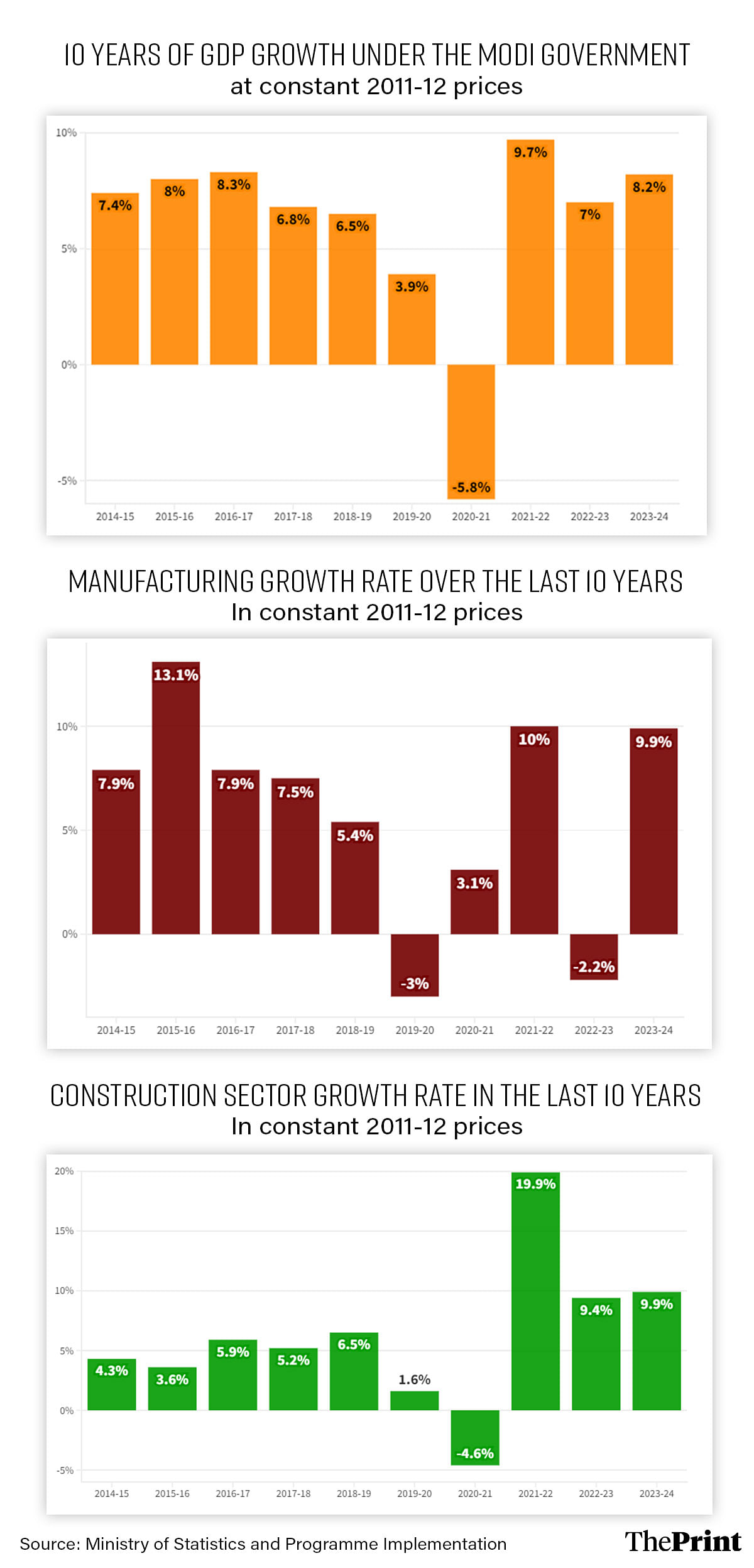New Delhi: A strong rebound in the manufacturing sector and a continued surge in construction and services has lifted India’s gross domestic product (GDP) growth to 8.2 percent in 2023-24, data released Friday showed.
GDP grew 7 percent in 2022-23.
Not counting the bounce-back in economic activity in 2021-22 following the COVID-induced lockdown the previous year, this is the fastest growth India has seen since 2016-17, when its GDP grew 8.3 percent.
This is also faster than the 7.6 percent growth the government had estimated for the year at the end of February 2024, and the 8 percent the Chief Economic Advisor had predicted earlier this month.

The Gross Value Added (GVA) grew at 7.2 percent in 2023-24, up from 6.7 percent in the previous year.
“One factor driving up GDP growth has been the high growth in net taxes by 19.1 percent which is due to a combination of higher tax collections and lower subsidy pay out,” Bank of Baroda chief economist Madan Sabnavis said. “GVA growth was 7.2 percent for the year. Hence, net taxes growth has contributed to the difference of 1 percent growth between GVA and GDP.”
The strong showing for the entire financial year 2023-24 was also made possible by a robust growth of 7.8 percent in the January-March quarter, even though this was the slowest quarterly growth in the year — 8.2 percent in Q1, 8.1 percent in Q2, and 8.6 percent in Q3.
Overall, the manufacturing sector grew 9.9 percent in 2023-24, although this came on a low base as the sector contracted 2.2 percent in 2022-23. In the fourth quarter of 2023-24, the manufacturing sector grew 8.9 percent compared with just 0.9 percent in the same quarter of the previous financial year.
That said, the growth in manufacturing in Q4 was slower than that seen in Q2 (14.3 percent) and Q3 (11.5 percent).
Apart from the base effect, Sabnavis said the higher profits that were recorded by manufacturing companies also added to the value added numbers, and hence the sector’s growth.
The other industrial sector to see robust growth was the construction sector, which grew 9.9 percent in 2023-24. What sets this sector apart from manufacturing is that this strong growth has come on a high base of 9.4 percent in 2022-23.
In Q4 of 2023-24, the construction sector registered a growth of 8.7 percent, up from 7.4 percent in the same quarter of 2022-23.
The agriculture sector, however, saw a significant slowdown to 2.1 percent in 2023-24, a likely result of the erratic monsoon. The sector had grown 4.4 percent in 2022-23.
The slowdown is even more stark in the fourth quarter of the financial year, with the sector slowing to a growth of 1.1 percent, compared with 7 percent in the fourth quarter of 2022-23.
The tertiary sector, which is a combination of the services sectors, grew a strong 7.6 percent in 2023-24, albeit slower than the 10 percent growth in 2022-23. Within this, the ‘financial, real estate and professional services’ sector saw the strongest growth of 8.4 percent, although even this was slower than the 9.1 percent growth in 2022-23.
The ‘trade, hotels, transport, and communications’ sector grew 6.4 percent in 2023-24, which is significantly slower than the 12 percent registered in 2022-23.
Notably, the contribution of household consumption to the economy has fallen further. Private final consumption expenditure, a proxy for household consumption, stood at 55.8 percent of GDP in 2023-24, down from 58 percent in 2022-23 and 58.1 percent in 2021-22.
The contribution of capital formation by the public and private sector to GDP — as measured by the gross fixed capital formation — remained flat at 33.5 percent in 2023-24, as compared to 33.3 percent in 2022-23 and 33.4 percent in 2021-22.
“While private final consumption expenditure growth is still languishing at 4.0 percent, the main demand side push is coming from gross fixed capital formation which has grown at 9.0 percent,” EY India chief policy advisor D.K. Srivastava said.
(Edited by Tony Rai)
Also Read: ‘Cesspool to historic profits’ — FM Sitharaman outlines ‘turnaround’ of banking sector under Modi






